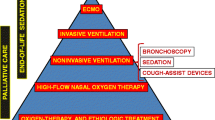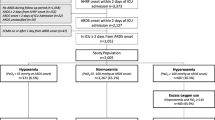Abstract
The management of acute respiratory failure is more complicated in elderly patients. The reasons behind this difficulty are mainly related to the frailty and the comorbidities. In particular, the frailty is characterised by a decline in physiological capacity across several organ systems, with a resultant increased susceptibility to stressors. In a few words, frailty means diminished organ reserve, including that of the lung. The first step in the management of acute respiratory failure remains to treat hypoxemia with oxygen therapy. The primary rationale of oxygen (O2) therapy is to prevent and correct arterial hypoxaemia (reduction of O2 in the blood) and any resulting hypoxia (the decrease of the O2 in the tissues) in patients with or at risk for impaired pulmonary gas exchange. The hypoxaemia is characterised by the partial pressure of O2 less than 60 mmHg in blood gas analysis or a SaO2 of <90% while breathing in room air [1]. Besides, over the last years, most acute treatment algorithms recommended the liberal use of a high fraction of inspired oxygen, even without first confirming the presence of a hypoxic insult. For example, for more than a century, supplemental oxygen has been used routinely in the treatment of patients with suspected acute myocardial infarction. The use of additional oxygen therapy in acute coronary syndromes (ACS) and cardiac emergencies has demonstrated to be controversial. In 2010, the American Heart Association (AHA) stated that oxygen should be delivered to patients with breathlessness, signs of heart failure, shock, or an arterial oxyhaemoglobin saturation <94% (Class I, LOE C) and not to all patients with ACS. Non-invasive monitoring of blood oxygen saturation can be useful to decide on the need for oxygen administration [2]. In 2015, some data questioned the consolidated clinical use of supplemental oxygen therapy. The Australian Air Versus Oxygen in Myocardial Infarction (AVOID) trial supported an adverse effect of oxygen. The trial reported larger infarct sizes in patients with ST-segment elevation myocardial infarction (STEMI) who received oxygen than in those who did not receive oxygen [3]. The history of oxygen supplementation in ACS is an example of the binary therapeutic option (liberal versus conservative use of oxygen). A Cochrane report from 2016 did not show any evidence supporting the routine use of oxygen in the treatment of patients with myocardial infarction [4]. In the same way for the treatment of stroke, the guidelines have affirmed that oxygen therapy may be harmful if used for non-hypoxemic patients with mild-moderate strokes [5]. Starting from these examples in this chapter, the authors analysed the evidence of oxygen therapy in the treatment of acute critical patients and acute respiratory distress syndrome (ARDS). The authors will investigate the use of oxygen therapy in light of the available physiopathological patterns of acute respiratory failure of COVID-19 disease.
Access this chapter
Tax calculation will be finalised at checkout
Purchases are for personal use only
Similar content being viewed by others
References
Kallstrom TJ. American Association for Respiratory Care (AARC) AARC clinical practice guideline: oxygen therapy for adults in the acute care facility—2002 revision & update. Respir Care. 2002;47(6):717–20.
O’Connor RE, Brady W, Brooks SC, et al. Part 10: acute coronary syndromes: 2010 American Heart Association guidelines for cardiopulmonary resuscitation and emergency cardiovascular care. Circulation. 2010;122(18 Suppl 3):S787–817. https://doi.org/10.1161/CIRCULATIONAHA.110.971028.
Stub D, Smith K, Bernard S, Nehme Z, Michael Stephenson RN, Bray JE, Cameron P, Barger B, Ellims AH, Taylor AJ, Meredith IT, Kaye DM, on behalf of the AVOID Investigators. Air versus oxygen in ST-segment–elevation myocardial infarction. Circulation. 2015;131:2143–50.
Cabello JB, Burls A, Emparanza JI, Bayliss SE, Quinn T. Oxygen therapy for acute myocardial infarction. Cochrane Database Syst Rev. 2016;12:CD007160.
O’Driscoll BR, et al. BTS guidelines 2017. Thorax. 2017;72:i1–i90. https://doi.org/10.1136/thoraxjnl-2016-209729.
Vargas M, Servillo G. Liberal versus conservative oxygen therapy in critically ill patients: using the fragility index to determine robust results. Crit Care. 2019;23:132. https://doi.org/10.1186/s13054-018-2165-z.
Girardis M, Busani S, Damiani E, et al. Effect of conservative vs conventional oxygen therapy on mortality among patients in an intensive care unit: the Oxygen-ICU randomized clinical trial. JAMA. 2016;316(15):1583–9. https://doi.org/10.1001/jama.2016.11993.
Barrot L, Asfar P, Mauny F, Winiszewski H, Montini F, Badie J, Quenot J-P, Pili-Floury S, Bouhemad B, Louis G, Souweine B, Collange O, Pottecher J, Levy B, Puyraveau M, Vettoretti L, Constantin J-M, Capellier G. Liberal or conservative oxygen therapy for acute respiratory distress syndrome. N Engl J Med. 2020;382(11):999–1008. https://doi.org/10.1056/NEJMoa1916431.
The ICU-ROX Investigators and the Australian and new Zealand Intensive Care Society Clinical Trials Group. Conservative oxygen therapy during mechanical ventilation in the ICU. N Engl J Med. 2020;382:989–98. https://doi.org/10.1056/NEJMoa1903297.
Damiani E, Donati A, Girardis M. Oxygen in the critically ill: friend or foe? Curr Opin Anaesthesiol. 2018;31(2):129–35.
Ni YN, Wang YM, Liang BM, Liang ZA. The effect of hyperoxia on mortality in critically ill patients: a systematic review and meta analysis. BMC Pulm Med. 2019;19(1):53. https://doi.org/10.1186/s12890-019-0810-1.
WHO. Oxygen therapy for children: a manual for health workers. Geneva: World Health Organization; 2013. http://www.who.int/maternal_child_adolescent/documents/child-oxygen-therapy/en/. Accessed 10 March 2020.
Rhodes A, Evans LE, Alhazzani W, Levy MM, Antonelli M, Ferrer R, et al. Surviving Sepsis campaign: international guidelines for Management of Sepsis and Septic Shock: 2016. Intensive Care Med. 2017;43(3):304–77. https://doi.org/10.1007/s00134-017-4683-6.
Gattinoni L, Coppola S, Cressoni M, Busana M, Rossi S, Chiumello D. Covid-19 does not lead to a “typical” acute respiratory distress syndrome. Am J Respir Crit Care Med. 2020;201(10):1299–300. https://doi.org/10.1164/rccm.202003-0817LE.
Gattinoni L, Chiumello D, Caironi P, et al. COVID-19 pneumonia: different respiratory treatments for different phenotypes? Intensive Care Med. 2020;46:1099. https://doi.org/10.1007/s00134-020-06033-2.
Author information
Authors and Affiliations
Editor information
Editors and Affiliations
Rights and permissions
Copyright information
© 2020 The Editor(s) (if applicable) and The Author(s), under exclusive license to Springer Nature Switzerland AG
About this chapter
Cite this chapter
Tibullo, L., Vargas, N., Esquinas, A.M. (2020). Oxygen Therapy: Liberal Versus Conservative in Older Patients with COVID Disease. In: Vargas, N., Esquinas, A.M. (eds) Covid-19 Airway Management and Ventilation Strategy for Critically Ill Older Patients. Springer, Cham. https://doi.org/10.1007/978-3-030-55621-1_13
Download citation
DOI: https://doi.org/10.1007/978-3-030-55621-1_13
Published:
Publisher Name: Springer, Cham
Print ISBN: 978-3-030-55620-4
Online ISBN: 978-3-030-55621-1
eBook Packages: MedicineMedicine (R0)




